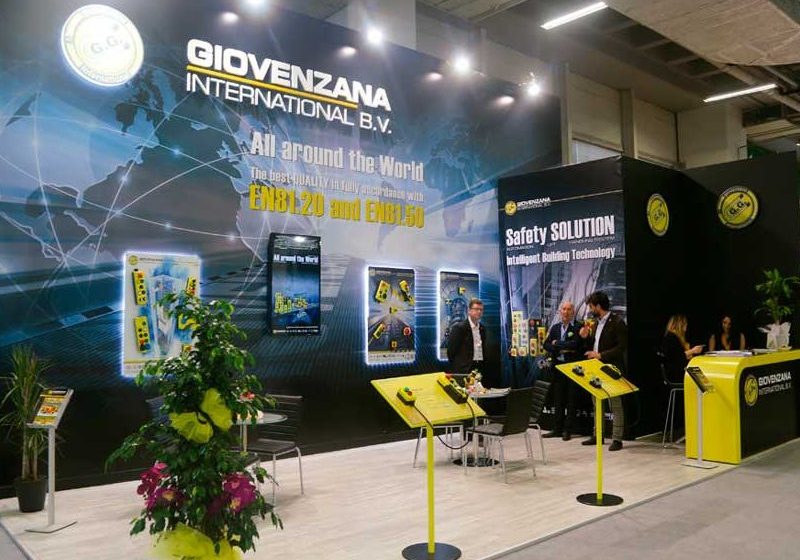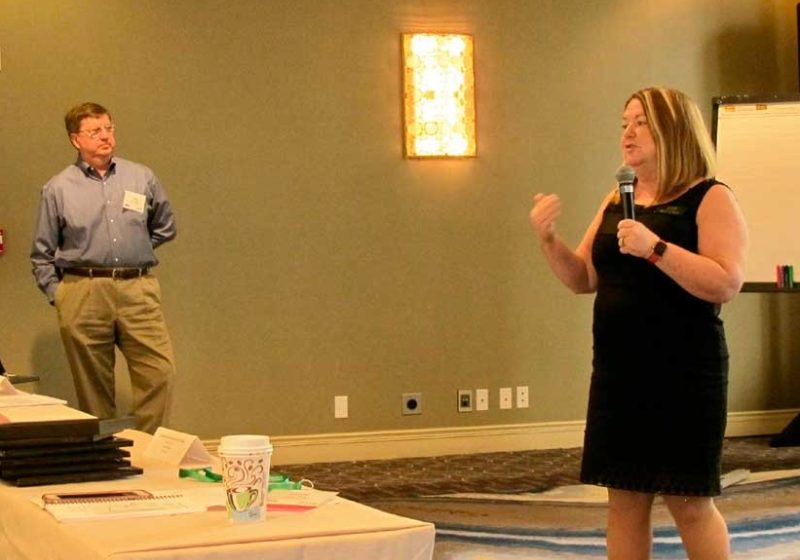Kevin Morse says Elevator U’s mission statement struck a chord.
Elevator Program Manager for Naval Facilities Engineering Command (NAVFAC) Kevin Morse (KM) began his career in the industry in the mid-1970s as an elevator constructor and mechanic with the International Union of Elevator Constructors (IUEC) Local 10 in Washington, D.C., but, in 1989, the U.S. Navy came knocking. That’s when Morse accepted a position with the NAVFAC, Chesapeake Division, as a NAVFAC certified elevator inspector at the Washington Navy Yard. He took over responsibility for the NAVFAC Elevator Program in 1993.
A National Association of Elevator Safety Authorities (NAESA) International-certified elevator inspector and inspection supervisor and a member of the ASME A17.1 Elevator Safety Code Committee, Morse is active in the industry and enjoys sharing his experiences and knowledge. Last month, he attended his first Elevator U Conference at the University of Virginia in Charlottesville, where he and NAVFAC Deputy Program Manager Dale Hughes presented a seminar titled, “Facility Management Best Practices — Elevator Design Criteria & Specifications.” ELEVATOR WORLD (EW) had a chance to talk with Morse prior to the conference and pick his brain about NAVFAC’s best practices and more.
EW: Your degree is in economics from the University of Maryland. Can you tell us how you ended up as an elevator mechanic?
KM: As you probably know, the elevator industry is a family business. During my senior year at Maryland, my soon-to-be father-in-law, Francis (Mac) McCamley, a 20-year Otis elevator mechanic who later worked for the Veterans Administration and NAVFAC as a Certified Elevator Inspection and Lead Certifying Offical, suggested that I take the IUEC hiring test, in case I was interested in working in the elevator trade. I scored well on the test and had a job offer soon after graduation. My experience of working as an elevator mechanic was tough, rewarding and something that has stayed with me for my entire life (in a good way). I don’t know where else you can earn a good living and garner knowledge and experience in electricity, electronics, hydraulics, motors and generators, microprocessor control and mechanical systems.
EW: Can you tell us a little bit about the variety of projects you worked on during your years with the union, and how that work led you to NAVFAC?
KM: I started working for Otis Elevator Co. on construction projects that included both elevators and escalators. I also worked for Westinghouse Elevator Co. before finding a home with ELCO Elevator Co. ELCO was a smaller elevator company with a new construction department and a larger elevator maintenance and service side. I can’t say that the experience led me to NAVFAC, but it definitely prepared me well for the variety of elevators I would be inspecting in Naval facilities. ELCO Elevator Co. would take on any make, model or vintage of elevator installation for a maintenance and service contract. With a small, independent company, you learn to read the electrical prints and recognize the safety and run circuits, regardless of the manufacturer. That was my favorite thing to do; running night calls and troubleshooting the relay logic controllers to find the problem, make the repair and put the elevator back in service. Now, with NAVFAC, we also manage an inventory with a wide variety of elevator makes, models and vintages. I expect that is a direct result of open-source contracting that encourages competitive bids from all qualified elevator installation contractors.
EW: How is working with the Navy different from working in a non-military or civilian organization?
KM: That’s a tricky question for me, because my transition was from elevator mechanic in the private sector to NAESA-certified elevator inspector with NAVFAC. The responsibilities of my job went from working on the equipment as an elevator mechanic to verification of safety-code compliance as a certified inspector. From the standpoint of inspection and certification, the NAVFAC organization allows us to communicate effectively and develop a network of experienced inspectors. Our approach has been to develop a cadre of experienced certified elevator inspectors who share their knowledge and experience with our newer, less-experienced elevator inspectors.
In addition to that, I must say that, as a group, the NAVFAC elevator inspectors feel a responsibility for, and take a great deal of pride and satisfaction in, working for something greater than themselves. We consider ourselves as the building owners and feel responsible for effective management of the elevator systems, both in terms of personnel safety and of the public funds that pay for the acquisition and sustainment of the elevator systems.
EW: Tell us about the scope of your work as NAVFAC program manager. What are your duties and what do you oversee?
KM: The NAVFAC Vertical-Transportation Equipment (VTE) Program is responsible for elevators, escalators and other types of fixed VTE in Navy and Marine Corps facilities service-wide. The breadth of the program includes military installations across the U.S. and outside the continental U.S. The scope of the program is multifaceted in that it includes safety-code certification management, elevator design criteria development, new-construction acceptance and commissioning, sustainment oversight and condition assessment with an eye toward planning for modernization.
Given that, I consider community management to be our most critical responsibility. The VTE Program depends on the continued development of safe and effective processes, certification management tools, and safety and technical training for the NAVFAC/QEI certified inspectors who are responsible for execution of the program at the Navy and Marine Corps installations around the world. Comprehensive knowledge and effective application of the building and safety codes, and adherence to safety practices and procedures, are emphasized throughout all of our classroom and field training. NAVFAC is a large global employer of engineers from all disciplines. I would encourage any engineers to look into a career with NAVFAC.
EW: You mentioned that the mission of Elevator U is similar to NAVFAC’s. In which ways?
KM: “The mission of the NAVFAC VTE Program is to develop policy and provide direction for VTE design, commissioning, certification, and sustainment to ensure safe, effective, and efficient procurement and operation of VTE in naval shore facilities.”
To accomplish those goals, we rely on a program built on consistent education, training and the dissemination of the program’s stated goals and objectives to every NAVFAC VTE inspector. This transfer of both vision and expertise is the only way we are able to achieve effective localized VTE support to our supported commands.
When I first read the mission statement for Elevator U, it seemed to express similar sentiment and purpose. The stated purpose of the organization is to promote excellence in design and construction and “…to facilitate the exchange of knowledge and technical expertise to properly build and maintain vertical transportation that is safe, durable, and efficient.” I would say we are definitely on the same page!
EW: Why did you choose to speak about facility management best practices?
KM: Between the two of us, Dale and I have 30 years of practical experience as elevator mechanics, and over 50 years of experience in execution, oversight and management of elevator construction, maintenance, repair and certification of elevators and escalators. Over that period, we have observed a lot of varied approaches to the design and installation of elevator systems and components.
In the development of elevator design criteria, we strive to maximize safe operation, effective performance, sustainable design, energy efficiency and lowest lifecycle cost. To do that, we evaluate the varied designs and make our criteria determinations from the perspective of the facility owner. I realized that, in our evaluation and development of elevator design criteria and specifications (specs), we had been using our knowledge and experience to procure elevator components and systems that are in the best interests of the building owner. I consider any effort in that direction to be a ‘Facility Management Best Practice.’
EW: What are some of the projects NAVFAC is working on currently? Which projects have you recently completed?
KM: We recently completed a coordinated effort that resulted in the publication of four new Department of Defense (DOD) Unified Facility Guide Specifications. Over a two-year period, Dale and I reorganized and updated the existing electric-traction and hydraulic elevator specs to make them clearer and more concise. During this process, we worked with several of our experienced certified elevator inspectors for review and comment. We then split the two specs into four, separating passenger requirements from freight, so a spec developer would not have to go through that process for each new construction project.
The NAVFAC Criteria Office was responsible for the next step of the process, which was to disseminate the new specs both within NAVFAC and out to our counterparts at the other military services. This step was a coordinated effort that included several iterations of draft, review and revision. As a result of a lot of hard work by many individuals, we now have four new Unified Facility Guide Specifications for DOD facilities. The specifications can be found on the Whole Building Design Guide website.
EW: Are you currently involved in any other interesting projects?
KM: It is interesting to me how things seem to have come full circle throughout my career in the elevator industry. In 1980, I was working as a temporary mechanic for Otis Elevator Company and was a member of the construction team that was installing new Otis electric traction elevators in the National Naval Medical Center and the new Uniform Services University of Health and Science, Bethesda, Maryland. At that time, state-of-the-art design included AC/DC generators, DC elevator drive motors and pie-plate selectors that controlled elevator car and hall call response, deceleration and leveling into the floor landing. Twenty-five years later, in 2005, I was conducting acceptance inspections on the same elevators, newly modernized with Swift microprocessor control. Twelve years later, now 2017, I am providing elevator condition assessment, safety code compliance and design support for the modernization of those same elevators. The only difference is that the Department of Defense installation is now named the Walter Reed National Military Medical Center.
Get more of Elevator World. Sign up for our free e-newsletter.









